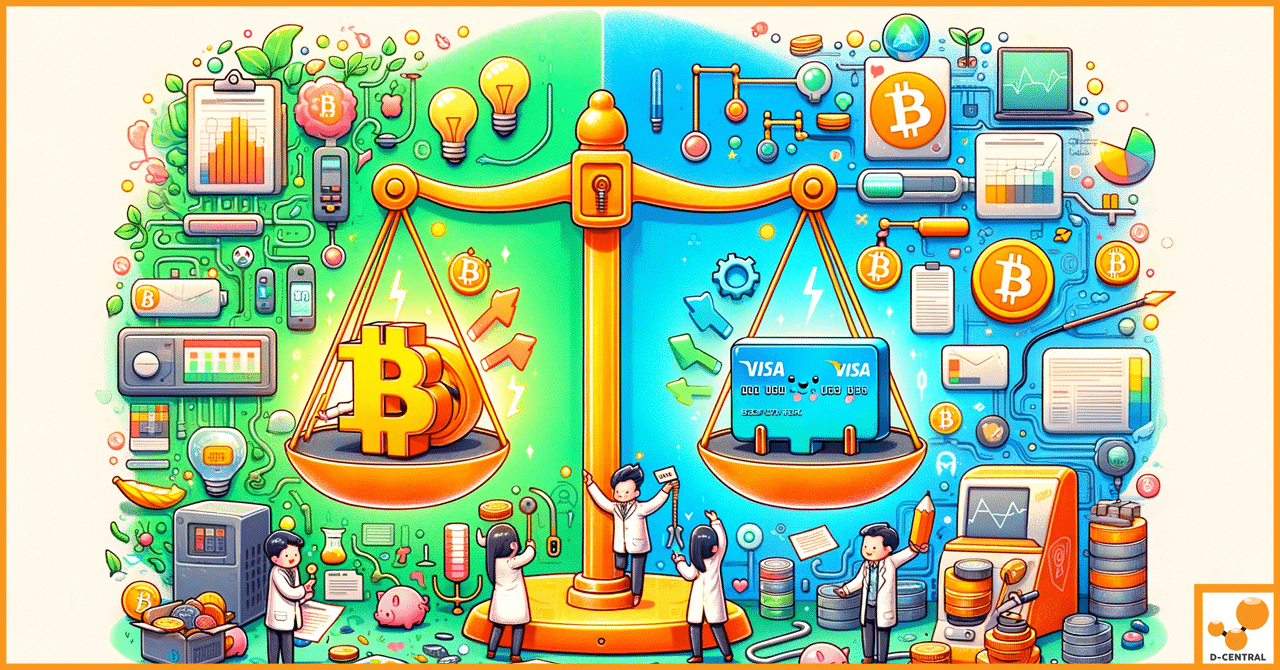
Why Bitcoiners Use Cold Storage Wallets: Secure Cryptocurrency Storage
In the digital age, Bitcoin has emerged as a revolutionary form of currency, transcending traditional financial boundaries and offering a
4479 Desserte Nord Autoroute 440, Laval, QC H7P 6E2

In recent years, a significant debate has emerged in the financial and technological communities regarding the energy consumption of Bitcoin, particularly when compared to traditional financial systems like VISA. A common misconception has taken root, suggesting that Bitcoin’s energy usage is excessively high, especially when measured on a per-transaction basis. This narrative has often led to hasty comparisons and conclusions, overshadowing the complexities and nuances of cryptocurrency mining and transaction processing.
At the heart of this discussion is D-Central Technologies, a leader in the Bitcoin mining industry. As Canada’s premier ASIC repair center and a trusted provider of mining hosting services, D-Central has been at the forefront of addressing these concerns. Our company not only specializes in the technical aspects of Bitcoin mining but also actively engages in the dialogue surrounding its environmental impact. With a deep understanding of the intricacies of Bitcoin’s infrastructure, including its energy consumption patterns, D-Central Technologies is uniquely positioned to shed light on this often-misunderstood topic.
In this exploration, we aim to dismantle the fallacy surrounding Bitcoin’s energy usage compared to VISA, providing a clearer, more accurate picture of where Bitcoin stands in the broader context of global energy consumption. By doing so, we hope to offer a more informed perspective on the sustainability and efficiency of Bitcoin mining, reflecting D-Central Technologies’ commitment to transparency and innovation in the cryptocurrency domain.
The widespread belief that Bitcoin’s energy consumption per transaction is alarmingly high compared to traditional financial systems like VISA is rooted in what is known as the “per transaction energy consumption” fallacy. This viewpoint suggests that the energy required to process a single Bitcoin transaction is vastly greater than that needed for a VISA transaction. However, this comparison is fundamentally flawed due to the distinct nature of the two systems.
Comparing Bitcoin and VISA Transactions
To put things into perspective, it’s essential to understand the different processes involved in Bitcoin and VISA transactions. Bitcoin, a decentralized cryptocurrency, relies on a network of miners who validate transactions and secure the blockchain. This process, known as proof of work, is energy-intensive but serves a broader purpose than mere transaction validation; it ensures network security and integrity. In contrast, VISA’s centralized system processes transactions through a well-established infrastructure with a different energy usage profile. VISA transactions, while numerous, are less energy-intensive on a per-transaction basis but are part of a centralized system with different security and operational requirements.
Flawed Methodology in Comparisons
The methodology used in comparing the energy consumption of Bitcoin and VISA transactions often overlooks several critical factors. Firstly, it fails to account for the total energy expenditure of the entire banking ecosystem, which includes not just transaction processing but also data centers, bank branches, ATMs, and the supporting financial infrastructure. Secondly, it ignores the fact that the energy cost of a Bitcoin transaction is not solely about processing the transaction itself but also involves maintaining the security and decentralization of the entire network. Lastly, such comparisons often do not consider the source of energy (renewable vs. non-renewable) and the efficiency improvements over time in Bitcoin mining technology.
In essence, while it’s undeniable that Bitcoin mining is energy-intensive, the “per transaction energy consumption” comparison with VISA is an oversimplification that does not accurately reflect the complexities and functionalities of both systems.
Bitcoin’s energy consumption, often a topic of intense debate, is primarily driven by the mining process. Mining involves solving complex cryptographic puzzles to validate transactions and add new blocks to the blockchain. This process, known as Proof of Work (PoW), is intentionally energy-intensive to ensure network security and prevent fraudulent activities. The energy expended in mining serves multiple purposes: it secures the network, facilitates decentralized consensus, and introduces new bitcoins into circulation through block rewards.
The Security Model of Bitcoin and Its Energy Requirements
The security of the Bitcoin network hinges on the PoW mechanism, where miners compete to solve mathematical problems. The first miner to solve the problem gets the right to add a new block to the blockchain and is rewarded with bitcoins. This competitive process requires substantial computational power and, consequently, a significant amount of energy. The rationale behind this energy expenditure is to make it economically unfeasible for any single entity to gain control of the network. The more decentralized the mining power, the more secure the network becomes, as it would require an impractical amount of resources to launch a successful attack.
Comparing Bitcoin’s Energy Sources with Traditional Banking Systems
When comparing Bitcoin’s energy sources to those of traditional banking systems, several key differences emerge. Traditional banking systems rely on a vast infrastructure that includes physical branches, ATMs, data centers, and an array of supporting IT systems. The energy consumption of this infrastructure is diffuse and extends beyond mere transaction processing, encompassing various aspects of financial services.
In contrast, Bitcoin’s energy consumption is more direct and transparent, primarily used for mining and network maintenance. Moreover, the Bitcoin mining industry has been increasingly moving towards renewable energy sources. Regions rich in renewable energy sources, such as hydroelectric power in Sichuan, China, or geothermal energy in Iceland, have become hubs for Bitcoin mining. This shift is driven partly by economic incentives, as renewable energy can be more cost-effective, and partly by a growing commitment within the Bitcoin community to reduce the environmental impact of mining.
While Bitcoin’s energy consumption is substantial, it serves critical functions in network security and decentralized consensus. Additionally, the Bitcoin ecosystem’s gradual shift towards renewable energy sources highlights a proactive approach to addressing environmental concerns, contrasting with the more traditional and less transparent energy usage patterns of conventional banking systems.
The Lightning Network represents a groundbreaking solution designed to address some of the scalability and energy efficiency challenges faced by Bitcoin. It operates as a second layer atop the Bitcoin blockchain, introducing a novel way to facilitate fast and cost-effective transactions. Unlike on-chain Bitcoin transactions, which require validation by miners, the Lightning Network enables peer-to-peer transactions that occur off-chain, significantly enhancing the scalability and efficiency of the Bitcoin network.
Explaining How the Lightning Network Enhances Transaction Efficiency
The Lightning Network revolutionizes Bitcoin’s transaction process by creating a network of payment channels. These channels are like private tunnels between users, enabling them to conduct transactions directly, off the main blockchain. Here’s how it works: Two parties open a payment channel by creating a multi-signature wallet on the blockchain. They can then perform an unlimited number of transactions between themselves within this channel, updating the balance as needed. Only the final channel balances are recorded on the Bitcoin blockchain, minimizing congestion and reducing transaction fees.
This approach provides several key benefits:
Discussing the Potential of the Lightning Network in Reducing Bitcoin’s Perceived Energy Consumption per Transaction
One of the most notable aspects of the Lightning Network is its ability to reduce the perceived energy consumption per Bitcoin transaction. Since the Lightning Network processes transactions off-chain and only settles the final balances on the Bitcoin blockchain, it effectively decouples transaction volume from the energy required to secure the network. This means that even as the number of Bitcoin transactions increases, the energy consumption per transaction remains relatively low.
The Lightning Network’s ability to handle a high volume of transactions with minimal energy expenditure has the potential to reshape the narrative surrounding Bitcoin’s energy efficiency. As this innovative technology gains wider adoption, it can significantly contribute to reducing the perceived environmental impact of Bitcoin while enhancing its utility for everyday transactions.
Beyond its role as a straightforward payment system, Bitcoin plays a pivotal role as a settlement layer in the broader financial landscape. In essence, Bitcoin serves as a digital equivalent of a settlement asset or reserve currency. While it can indeed be used for day-to-day transactions, its primary strength lies in facilitating large-value transfers and settlements between entities across the globe.
Traditional financial systems also employ settlement layers. These are specialized components within the broader infrastructure that ensure the secure and efficient transfer of assets between financial institutions, such as banks. In the conventional banking world, these settlement layers are often operated by central authorities and involve intricate processes to verify and finalize transactions.
Comparing Bitcoin’s Settlement Function with Traditional Systems
When comparing Bitcoin’s role as a settlement layer with that of traditional financial systems, several key distinctions become evident.
Impact on Energy Consumption Analysis
Understanding Bitcoin’s role as a settlement layer is crucial when analyzing its energy consumption. While individual Bitcoin transactions may appear energy-intensive, they represent a small fraction of the network’s total energy expenditure. The vast majority of energy is directed towards securing the blockchain and maintaining its decentralized nature. This means that the energy cost of processing large settlements on the Bitcoin network is significantly lower than that of traditional settlement layers.
Moreover, as Bitcoin continues to evolve and integrate solutions like the Lightning Network, it becomes increasingly efficient as a settlement layer. Lightning Network transactions are near-instantaneous and consume minimal energy compared to on-chain transactions. This innovation further underscores Bitcoin’s potential to rival or even surpass traditional financial settlement layers in terms of efficiency and cost-effectiveness.
In essence, recognizing Bitcoin’s role as a settlement layer reframes the energy consumption debate by emphasizing its efficiency in processing large-value transactions, a function crucial to the global financial system.
As the Lightning Network gains traction as a transformative solution for Bitcoin’s scalability and efficiency, an intriguing possibility emerges: the integration of traditional payment processors like VISA and Mastercard into the Lightning Network ecosystem. This integration could establish them as liquidity hubs within this emerging decentralized financial infrastructure.
Imagine a scenario where traditional payment giants leverage their extensive networks and expertise to become key players in the Lightning Network. By doing so, they would bridge the gap between the conventional financial world and the decentralized realm of cryptocurrencies, offering users the best of both worlds.
Discussing the Benefits and Potential Challenges of this Integration
Benefits:
Challenges:
The integration of VISA, Mastercard, and other traditional payment processors into the Lightning Network could reshape the financial landscape in profound ways. We may witness a coexistence of centralized and decentralized financial systems, each offering unique advantages to users.
In this future landscape, users could choose between Lightning Network-powered transactions for their speed, cost-efficiency, and global reach, while traditional financial systems continue to provide essential services. This coexistence may foster healthy competition and innovation, ultimately benefiting consumers.
D-Central Technologies is dedicated to staying at the forefront of these developments, ensuring that our services remain aligned with the evolving needs of the cryptocurrency and blockchain ecosystem. As the boundaries between traditional and decentralized finance blur, we are committed to facilitating a seamless transition for our clients and partners into this exciting new era.
One of the most prominent concerns surrounding Bitcoin is its environmental impact, particularly related to mining. Bitcoin mining consumes a significant amount of energy, and a portion of this energy comes from non-renewable sources. Critics argue that the carbon footprint of Bitcoin mining is a matter of concern, considering the global push for sustainable practices.
While Bitcoin mining does have an energy footprint, the cryptocurrency community has not been idle in addressing these concerns. Several initiatives and technologies have emerged to make Bitcoin mining more sustainable:
When assessing Bitcoin’s environmental impact, it’s essential to compare it with the environmental footprint of traditional banking systems. While Bitcoin mining consumes energy, the energy footprint of traditional financial systems is also substantial.
Traditional banks operate extensive data centers, branch networks, and ATM networks, all of which require electricity. Additionally, the infrastructure for credit card processing and financial services has a significant energy demand. When considering the entire ecosystem, traditional banking systems contribute to global energy consumption and environmental impact.
In contrast, Bitcoin mining, while energy-intensive, is relatively transparent and localized in comparison. The Bitcoin community’s proactive approach to sustainability, including the adoption of renewable energy sources and the development of environmentally friendly technologies, underscores its commitment to addressing environmental concerns.
It is crucial to recognize that the energy consumption debate surrounding Bitcoin is not one-sided, and the cryptocurrency industry is actively exploring solutions to minimize its environmental impact.
In this comprehensive exploration of the Bitcoin vs. VISA electricity consumption fallacy, we have delved into the heart of a critical debate surrounding cryptocurrency’s environmental impact. It is essential to summarize the key takeaways and emphasize the significance of nuanced comprehension:
The overarching message of this discourse is clear: accurate and nuanced comprehension of Bitcoin’s energy consumption is paramount. Oversimplifications and misconceptions obscure the intricate dynamics at play within the cryptocurrency ecosystem. By fostering informed dialogue and dispelling fallacies, we can arrive at a more balanced perspective on Bitcoin’s environmental impact.
We urge our readers to delve further into the realm of Bitcoin mining, sustainability, and innovation. It is a space brimming with potential and opportunities for positive change. Exploring sustainable practices in cryptocurrency mining is not just an environmental endeavor but also a testament to the adaptability and progressiveness of the cryptocurrency community.
For those seeking in-depth knowledge, services, or support in the realm of Bitcoin mining, we invite you to connect with D-Central Technologies. As Canada’s premier ASIC repair center and a trusted provider of mining hosting services, D-Central is at the forefront of the industry. Our commitment to transparency, innovation, and sustainability aligns with the highest standards in the cryptocurrency domain.
What is the “per transaction energy consumption” fallacy regarding Bitcoin?
The “per transaction energy consumption” fallacy refers to the misconception that the energy required to process a single Bitcoin transaction is excessively high compared to traditional financial systems like VISA, without acknowledging the different roles and processes of each system.
How do Bitcoin and VISA transactions differ in terms of energy consumption?
Bitcoin relies on a decentralized network where mining secures the blockchain through energy-intensive processes, serving broader purposes than just transaction validations. VISA processes transactions in a centralized system with a different energy usage profile, focusing on immediate transaction processing.
What is Bitcoin’s Proof of Work (PoW) mechanism?
Bitcoin’s PoW is a process where miners compete to solve complex cryptographic puzzles to validate transactions and secure the network, requiring significant computational power and energy to maintain security and decentralize control.
How does the energy source of Bitcoin mining compare to traditional banking?
Bitcoin mining has been moving towards renewable energy sources, such as hydroelectric or geothermal power, whereas traditional banking systems encompass a variety of energy-consuming operations (branches, ATMs, data centers) not solely related to transaction processing.
What is the Lightning Network and how does it affect Bitcoin’s transaction efficiency?
The Lightning Network is a second-layer solution on top of the Bitcoin blockchain that enables off-chain peer-to-peer transactions, improving the scalability and efficiency of Bitcoin by allowing fast, low-cost transactions with minimal energy consumption.
How does Bitcoin’s role as a settlement layer affect energy consumption analysis?
Bitcoin as a settlement layer emphasizes large-value transfers rather than individual transaction efficiency. This focus reduces the energy cost per settlement on the Bitcoin network compared to traditional settlement layers, offering effective processing of substantial financial transfers.
Could traditional payment processors integrate with the Lightning Network?
Integration is possible and would combine the advantages of traditional financial infrastructure with decentralized cryptocurrency systems, potentially providing faster transactions, global reach, and compliance while maintaining the values of cryptocurrencies such as blockchain transparency.
What initiatives are being taken to make Bitcoin mining more sustainable?
Multiple initiatives are underway, including increasing renewable energy adoption for mining, utilizing flare gas for electricity generation, mitigating methane emissions, developing dual-purpose mining equipment, and participating in grid stabilization efforts.
How does D-Central Technologies engage in the debate on Bitcoin’s environmental impact?
D-Central Technologies, as a leading entity in the Bitcoin mining industry, actively participates in the dialogue surrounding the environmental impact of cryptocurrency, specializing in Bitcoin mining technical aspects and sustainability.
Where can one learn more or engage D-Central Technologies’ services?
Individuals interested in gaining more knowledge or seeking services in Bitcoin mining can reach out to D-Central Technologies, a reputable ASIC repair center and provider of mining hosting services known for its commitment to industry standards and sustainability.
DISCLAIMER: D-Central Technologies and its associated content, including this blog, do not serve as financial advisors or official investment advisors. The insights and opinions shared here or by any guests featured in our content are provided purely for informational and educational purposes. Such communications should not be interpreted as financial, investment, legal, tax, or any form of specific advice. We are committed to advancing the knowledge and understanding of Bitcoin and its potential impact on society. However, we urge our community to proceed with caution and informed judgment in all related endeavors.
Related Posts

In the digital age, Bitcoin has emerged as a revolutionary form of currency, transcending traditional financial boundaries and offering a

In recent years, cryptocurrency mining has transformed from a niche hobby into a major industrial activity, largely due to the

Discover how you can join the future of decentralized finance while promoting sustainability. This comprehensive guide explores the synergy between